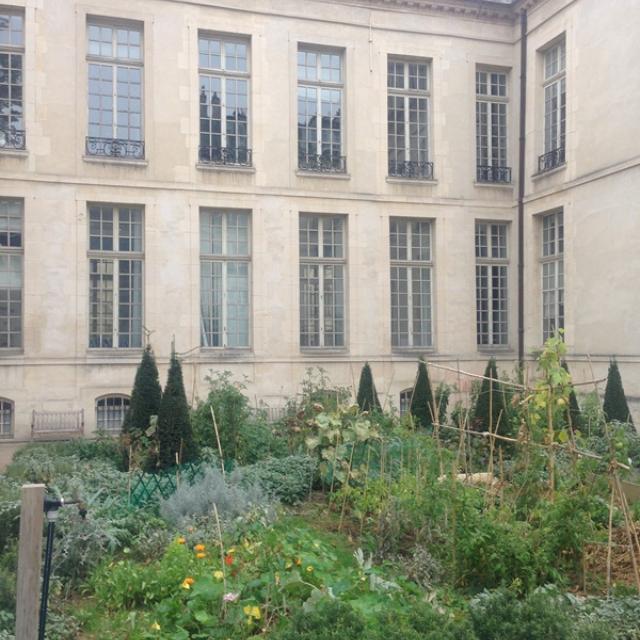Rooftop vegetable gardens, communal gardens, use of wastelands… there is an increasing tendency to use small green spaces for food-production in the large cities. Apart from supplying fruits and vegetables produced locally, urban agriculture develops social contact, allows for the recycling of organic waste, reduces the heat island effect and improves local biodiversity.

It all began in New York in the 1970s
In New York during the 1970s the « green guerrillas » movement gradually began to take root with its activists throwing seed bombs over wire netting fences in order to get flowers growing on vacant urban lots. As time went by, the movement gained momentum with the first community garden in history beingestablished in Manhattan in 1973. This was an urban lot transformed into a garden, communally maintained and managed by a group of local inhabitants.
During the same period, “community gardens” began to emerge in Canada.
In England, many community gardens and urban farms have sprung up since the 70s. Today, there are more than 30 « urban farms » in London, bringing a little bit of the countryside to the city.
In Germany and France, the concept was introduced a little later, in the 1990s.
This happened in Berlin, for example, where, given the very low cost of real estate, there are a number of fallow or set-aside areas offering the possibility of short- or long-term reallocation.
The French produced the first community garden in Lille, in 1997, adopting the American model.
A wide variety of urban gardens driven by different incentives
Garden roofs, community gardens, use of waste ground… a flood of different forms of greenery has now appeared in the city centres of France and Europe, following the pattern of North America. In the “Île de France” district of Paris, first results show that the total surface area of the community gardens (or allotments) could one day equal the area dedicated to professional market gardening. And in Marseilles, there are thousands of small plots where garden vegetables are grown on some thirty hectares.
This recent phenomenon can be explained by the climate change and a succession of different food scandals (mad cow disease, dioxins in chicken), which have brought into question the different forms of intensive food production and where they are located. This is demonstrated, for example, by the success of the short chain systems, as promoted by AMAP (Association dedicated to the Conservation of Family Smallholdings) or the return of farmers’ markets, where the producers gather together at a given place to sell their products directly. But when the economic crisis of 2008 hit, whatever the size of the plots, the project leaders would nearly always want to know about the potential for food production. This new trend represents a substantial means of support for large number of urban households by guaranteeing a supply of food, particularly forthose of modest means.
However, the utopian dream of having vast areas dedicated to urban food production collides with the stark reality of the pressure on land and property, especially where the major cities of Europe are concerned. And there is also the problem of the polluted urban soil (this being the case in Paris, in particular), which cannot be reused for growing crops.
Therefore, rooftop agriculture can be seen as a possible alternative as it does not occupy any horizontal space in our cities and is far removed from the risks associated with this soil pollution. It is expanding very rapidly in a number of European cities. In Paris, for example, the mayor, Anne Hidalgo, has joined the trend by indicating her willingness to create « one hundred roof gardens, of which 30 hectares will produce food ».
So there are many types of urban gardens: this could range from green roofs or roof gardens to community gardens or allotments or even a few vegetables grown on your balcony.Not all urban garden experiences share the same dynamics though: this could be a simple leisure activity or a real commercial business, or it could be a project that seeks to restore the social connection between city-dwellers or a means of providing a food supplement for families of modest means.
What crops are you going to grow in your urban garden and how are you going to irrigate them?
A wide variety of vegetables can be grown in the containers, pots and tubs of an urban garden: including aubergines, beetroot, carrots, courgettes, lettuces, radishes, tomatoes… Some vegetables have a short growing period and a very shallow rooting system, requiring regular but small amounts of irrigation; while others having very well developed roots and needing a number of months over the summer period to develop and grow such as tomatoes or melons, to name a few, will be more demanding. In the case of winter vegetables, for most of the timenatural rainfall will be enough with some fresh air made available during the dry periods. Quick-growing vegetables, such as lettuces and radishes, require a regular supply of water albeit over a very short period of time.
Setting up an automatic irrigation system with a controlleractivated to begin watering at nightfall, is a good solution for vegetables that require plenty of water. Economicaldrippers placed directly at the foot of the plants with an adjusted flow rate adapted to each type of crop, will apply the precise amount of water necessary to ensure optimum growth. This solution is ideal for the efficient watering of melons, water melons and tomatoes.
Water quality is also important because some heavily treated municipal water supplies could alter the pH of the soil, causing deficiencies and diseases. If at all possible, try to make use of the rainwater, which is neutral and contains micronutrients. Equip your garden with rainwater recovery tanks and other kinds of receptacles that will allow you to harvest this “blessing” that falls from the sky and put it to good use. If the above proves to be impossible, then allow the tapwater to settle for 24 hours before using it.
Some tips for restricting water consumption: never allow the soil to be invaded by weeds. These draw the water from the surface before it can reach the roots of the vegetable plants. With competition being fierce, the plants would inevitably suffer. Hoe the soil regularly to prevent weeds appearing and aerate the soil for optimum irrigation.
Another technique essential for urban gardens is mulching. Whether it consists of lawn clippings, flax straw, crushed dry leaves or any other plant residues, a thick layer of mulch will, in one single step, prevent weed growth, nourish the soil and reduce irrigation frequency because it allows the soil to stay fresh.
Riding on the crest of an ecological wave, urban agriculture is booming throughout the world. Apart from bringing city-dwellers closer to nature, these gardens have become places for sharing and exchanging ideas and providing a convivial atmosphere. Another advantage is the recycling of waste: urban green waste compost is beneficial for the plants and often results in better yields. Furthermore, biodiversity responds very favourably to these projects. We see, for example, a proliferation of earthworms, which are often considered to be the engineers of the earth and eco-system. These green zones also act as a haven for many species of birds and bees.

